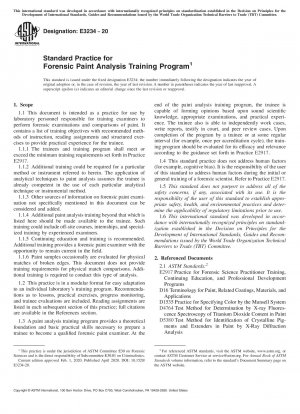ASTM E3234-20
Standard Practice for Forensic Paint Analysis Training Program
- Standard No.
- ASTM E3234-20
- Release Date
- 2020
- Published By
- American Society for Testing and Materials (ASTM)
- Latest
- ASTM E3234-20
- Scope
- 1.1 This document is intended as a practice for use by laboratory personnel responsible for training examiners to perform forensic examinations and comparisons of paint. It contains a list of training objectives with recommended methods of instruction, reading assignments and structured exercises to provide practical experience for the trainee. 1.1.1 The trainees and training program shall meet or exceed the minimum training requirements set forth in Practice E2917. 1.1.2 Additional training could be required for a particular method or instrument referred to herein. The application of analytical techniques to paint analysis assumes the trainee is already competent in the use of each particular analytical technique or instrumental method. 1.1.3 Other sources of information on forensic paint examination not specifically mentioned in this document can be considered and added. 1.1.4 Additional paint analysis training beyond that which is listed here should be made available to the trainee. Such training could include off-site courses, internships, and specialized training by experienced examiners. 1.1.5 Continuing education and training is recommended. Additional training provides a forensic paint examiner with the opportunity to remain current in the field. 1.1.6 Paint samples occasionally are evaluated for physical matches of broken edges. This document does not provide training requirements for physical match comparisons. Additional training is required to conduct this type of analysis. 1.2 This practice is in a modular format for easy adaptation to an individual laboratory’s training program. Recommendations as to lessons, practical exercises, progress monitoring, and trainee evaluations are included. Reading assignments are listed in each subsequent section of this practice; full citations are available in the References section. 1.3 A paint analysis training program provides a theoretical foundation and basic practical skills necessary to prepare a trainee to become a qualified forensic paint examiner. At the end of the paint analysis training program, the trainee is capable of forming opinions based upon sound scientific knowledge, appropriate examinations, and practical experience. The trainee also is able to independently work cases, write reports, testify in court, and peer review cases. Upon completion of the program by a trainee or at some regular interval (for example, once per accreditation cycle), the training program should be evaluated for its efficacy and relevance according to the guidance set forth in Practice E2917. 1.4 This standard practice does not address human factors (for example, cognitive bias). It is the responsibility of the user of this standard to address human factors during the initial or general training of a forensic scientist. Refer to Practice E2917. 1.5 This standard does not purport to address all of the safety concerns, if any, associated with its use. It is the responsibility of the user of this standard to establish appropriate safety, health, and environmental practices and determine the applicability of regulatory limitations prior to use. 1.6 This international standard was developed in accordance with internationally recognized principles on standardization established in the Decision on Principles for the Development of International Standards, Guides and Recommendations issued by the World Trade Organization Technical Barriers to Trade (TBT) Committee.
ASTM E3234-20 Referenced Document
- ASTM D1535 Standard Practice for Specifying Color by the Munsell System
- ASTM D16 Standard Terminology for Paint, Related Coatings, Materials, and Applications
- ASTM D4764 Standard Test Method for Determination by X-ray Fluorescence Spectroscopy of Titanium Dioxide Content in Paint
- ASTM D5380 Standard Test Method for Identification of Crystalline Pigments and Extenders in Paint by X-Ray Diffraction Analysis*, 2021-02-01 Update
- ASTM D5381 Standard Guide for X-Ray Fluorescence (XRF) Spectroscopy of Pigments and Extenders*, 2021-02-01 Update
- ASTM E1459 Standard Guide for Physical Evidence Labeling and Related Documentation
- ASTM E1492 Standard Practice for Receiving, Documenting, Storing, and Retrieving Evidence in a Forensic Science Laboratory
- ASTM E1610 Standard Guide for Forensic Paint Analysis and Comparison
- ASTM E2808 Standard Guide for Microspectrophotometry in Forensic Paint Analysis*, 2021-09-01 Update
- ASTM E2809 Standard Guide for Using Scanning Electron Microscopy/Energy Dispersive X-Ray Spectroscopy (SEM/EDS) in Forensic Polymer Examinations*, 2022-01-01 Update
- ASTM E2917 Standard Practice for Forensic Science Practitioner Training, Continuing Education, and Professional Development Programs*, 2024-02-01 Update
- ASTM E2937 Standard Guide for Using Infrared Spectroscopy in Forensic Paint Examinations
- ASTM E308 Standard Practice for Computing the Colors of Objects by Using the CIE System
ASTM E3234-20 history
- 2020 ASTM E3234-20 Standard Practice for Forensic Paint Analysis Training Program
